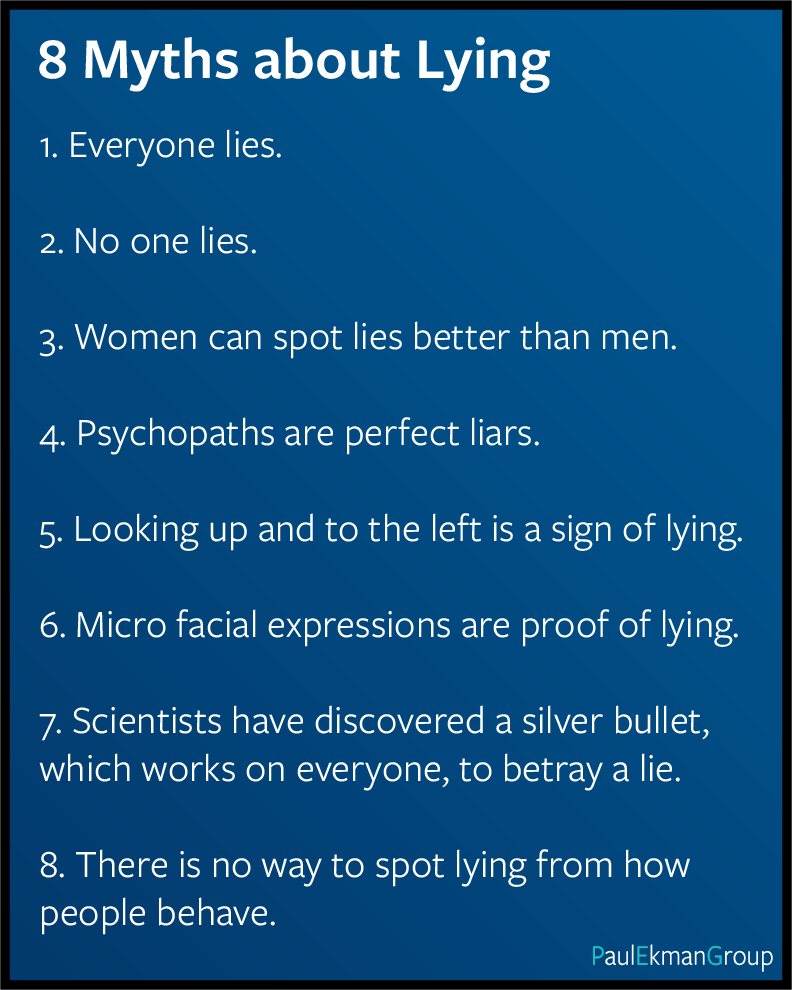June 8, 2015

Myths about Lying
by Paul Ekman, Ph.D. as featured on Forbes.
Myth #1 – Everyone lies.
Not so. Not about serious matters, not about lies which if caught could result in the end of a relationship, employment, freedom, large sums of money or life itself. Those are what I call high stake lies; they are the lies that the police and the FBI and insecure spouses are trying to catch. They are the lies of the criminal, the terrorist, the philanderer, the embezzler, and what the cops call ‘bad guys’.
Myth #2 – No one lies.
Hardly. Nearly everyone tells low stake lies. Politeness, for example, or praising the host for a dull dinner and conversation, flattery, and so forth. No one really expects to be told the truth in those situations.
Myth #3 – Women can spot lies better than men.
No they can’t; most people are terrible lie catchers, fooled by high stake lies again and again. Often they want to believe the liar. Do you want to find out your lover is unfaithful, your children are using hard drugs, the person you recommended for the job is embezzling? These are hard truths to accept, so the target of the lie often cooperates in being misled because the truth is too painful.
Myth #4 – Psychopaths are perfect liars.
Psychopaths are no more skillful at lying than anyone else, but they are so charming we want to believe them, and we do.
Myth #5 – Looking up and to the left is a sign of lying.
The research shows that which way you look before answering a question is unrelated to whether you are lying.
Myth #6 – Micro facial expressions are proof of lying.
Fleeting facial expressions do reveal an emotion that is being concealed, and that is a kind of lie, but innocents under suspicion may conceal their fear, or anger about being suspected. You need to find out why they are concealing their emotions in order to judge whether it is sign they are guilty of the offense you are investigating.
Myth #7 – Scientists have discovered a silver bullet, which works on everyone, to betray a lie.
We don’t have Pinocchio’s nose. Nothing exists which, if absent, means the person is truthful and if present is proof of lying. The polygraph, the so-called lie detector, is just a little bit better than chance. Yet it does have its use in a criminal investigation—if only one of the suspects fails the test, he or she is the first one to investigate, bearing in mind that this suspect may be the most nervous or worried about not being believed, though innocent.
Myth #8 -There is no way to spot lying from how people behave.
There are what I like to call ‘hot spots’ which indicate you are not getting the full story. If you really do want to catch a liar there are nearly thirty different hot spots to pay attention to. Micro facial expressions and gestural slips are the two most important ones, but there are many more.
For example, a slight shrug, usually of one shoulder, coinciding with a verbal statement of confidence is an example of a ‘hot spot’ revealed in a gestural slip. Something is awry. Another is a slight head shake no, only very slight, when saying ‘yes.’


One Comment on “
8 Myths about Lying
Lying facts and fiction
”I am currently studying psychological profiling and I am covering the theory of deception. Could you please tell me what direct eye contact and looking to the left mean when answering a question as there is many mixed opinions on this and even the answer in my textbook is confusing. Much appreciated